IDR Blog
The Long March to Siachen
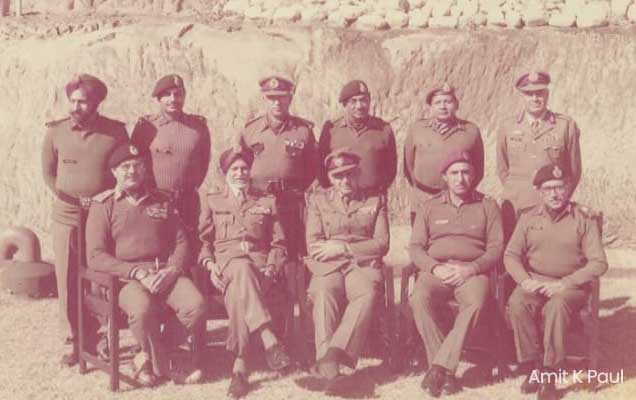
From Left to Right: Maj.Gen Amarjit Singh (standing) and sitting Lt. Gen Hoon, Lt. Gen. Cheema, Lt. Gen. Chibber
The Crucial Meeting
After preliminary discussions with Gen. A S Vaidya, the Chief of Army Staff (COAS) around 9th of February 1984, a crucial meeting was called by the Northern Army Commander, Lt. Gen. M L Chibber in his Office at the Northern Command, Udhampur on 14th of February. The objective of this meeting was to finalize the blueprint for the impending Operation on the Saltoro Ridge to pre-empt the Pakistani occupation of Siachen Glacier.
This meeting was attended by Lt. Gen P N Hoon, GOC 15 Corps, Lt. Gen N S Cheema, Chief of Staff and Maj. Gen. Amarjit Singh, MGGS amongst others. Several important decisions were taken after the deliberations. Lt. Col. Pushkar Chand CO 1 VIKAS was appointed as the Task Force Commander responsible for controlling the Operations. He was to be given personnel other than 1 VIKAS Battalion troops by Headquarter (HQ) 15 Corps and his own HQ was to be located at the Forward Logistics Base (FLB) which was to be established near the Teram Shehr Glacier. Thus while overseeing the Operation Lt. Col. Pushkar Chand was to practically shuttle between the Base Camp and the FLB.
Depending on the intelligence, the plan was to cater for the occupation of Bilafond La and Sia La by air earlier than what had been originally planned.
Force Composition:
The Force deployed for the entire Operation comprised of one Company plus Platoon of Ladakh Scouts and one Company of 4 KUMAON with supporting elements.
Additionally 19 KUMAON less two Companies was to move its Battalion Headquarters from, Khrew to somewhere between Sasoma and the Base Camp and be available as a reserve at the disposal of the 26 SECTOR Commander to cater for any situation that might arise. Maj. S C Thakur, the Second-in-Command (2IC) of the Battalion with two Company groups was to be suitably located and dedicated as reserve for the Turtok area.
Similarly 4 KUMAON less a Company from their location in Sub Sector West was to cater for any contingency opposite Turtok area.
The Strategy
The Force for this Operation was to be maintained by air through para drops by fixed wing aircrafts while the helicopter effort was primarily earmarked for tasks such as reconnaissance, movement of reaction force, casualty evacuations and reinforcements. HQ 15 Corps was directed to activate its sources across the border especially in Khapalu to provide intelligence about any movement of Pak troops towards Bilafond La and Sia La.
Depending on the intelligence, the plan was to cater for the occupation of Bilafond La and Sia La by air earlier than what had been originally planned. Even though it was not expected, HQ 15 Corps was directed to adequately prepare itself for any escalation by Pakistan in its region.
In order to ensure adequate strength to defend the positions and a smooth supply line for the heli-borne troops it was essential that their link up with the ground forces be completed swiftly.
Subsequently the entire strategy was war gamed on 26th March 1984 when Exercise Walnut Cracker was held at the Corps HQ in Srinagar. It was decided to occupy both Bilafond La and Sia La using heli-borne troops who would immediately proceed to secure both the passes and patrol all ingress routes to prevent any intrusion from the other side.
In order to ensure adequate strength to defend the positions and a smooth supply line for the heli-borne troops it was essential that their link up with the ground forces be completed swiftly. For this purpose six camps in addition to the patrol bases and FLB were proposed to be established on the glacier each within one days turn round.
The entire theatre of operations was divided in two parts between 4 KUMAON and Ladakh Scouts with 19 KUMAON kept in reserve.
The Tasks:
One Company of 4 KUMAON led by Major Sandhu with Captain Sanjay Kulkarni as his 2IC was tasked with the responsibility of (a) establishing Camps I,II and III by one platoon (b) securing Bilafond La by one platoon lifted by helicopters (c) providing one platoon as reserve for Bilafond La and (d) patrolling and dominating areas towards Saltoro Kangri, Ali Brangsa and Teram Shehr Glacier.
One Company plus Platoon of Ladakh Scouts led by Major Bahuguna with Captain Baldev Singh as his 2IC were entrusted with the responsibility of (a) holding Sia La by one platoon lifted by helicopters (b) establishing camps IV,V,VI by one platoon (c) providing a platoon less section as reserve for Sia La (d) consolidating the base camp by one platoon plus one section and (e) patrolling towards Indira Col.
The troop deployment of Operation Meghdoot commenced on 13th April 1984 with the first Chopper taking off and the foot column commencing its march at around 5 AM in the morning.
4 KUMAON:
Maj R S Sandhu and Captain Sanjay Kulkarni with one platoon were heli-dropped about three kilometres short of Bilafond La on 13th April. ‘The general area of Bilafond La was secured on 13th April itself while the establishment and strengthening of posts on the La was completed by 17th April as movement was very difficult between 13th and 16th due to blizardous conditions’, recalls Lt.Gen. Sanjay Kulkarni (Retd.)
Simultaneously on 13th itself at the same time a foot column led by Captain Paramvir Yadav started from the Base Camp with the objective of linking up with the heli-dropped Bilafond La troops and connecting them with the Base Camp through a land line.
Captain Gusain established Camp I, Camp II and Camp III by 13th, 14th and 15th April respectively while the link up force under Captain Paramvir Yadav established the patrol base near Bilafond La and linked up with the Task Force Commander at the FLB by 18th April.
‘Lt. Col Pushkar Chand flew to the proposed location of the FLB on 18th and we could also see the MI-8’s dropping their loads at the FLB which appeared very close to our location near Camp III. However we took nearly ten to twelve hours and reached it only in the evening.
Thereafter we took another day or so to set up the FLB,’ vividly recalls Colonel Paramvir Yadav (Retd.)
Ladakh Scouts:
As per plan Major Bahuguna and Captain Baldev Singh with one platoon were to beheli-dropped at Sia La on 13th itself but unfortunately the weather packed up and this could not be done.
‘Since the mission could not be jeopardized therefore it was decided that the Choppers should fly as close to Sia La as soon as the weather permits. On the 17th the weather started improving a bit so 12 of us were heli-dropped somewhere between the proposed locations of Camp IV and Camp V and we started slowly moving towards Sia La. As the weather improved we could see Choppers flying over us headed towards Sia La’, recalls Col Baldev Singh (Retd.).
Major Bahuguna and the others were dropped about 3 to 5 kms short of Sia La and secured the region. Subsequently Captain Baldev Singh and his foot column linked up with Major Bahuguna and after reinforcing their position at the Sia La patrol base they started moving forward to consolidate the positions on the pass. ‘Once I linked up with Major Bahuguna we established our posts on the pass and started dominating all the mounds around it’, recalls Col. Baldev Singh (Retd.).
Meanwhile another foot column led by Major Salaria was on its way to the glacier and this column established Camp IV,V and VI by 22nd, 24th April and 26th April respectively. Thereafter the force was split into two parts with one establishing the assault camp for Indira Col and the other under Major Salaria moving on to link up with the Sia La post on 29th April.
With the establishment of all the Camps, and the link up of the forward posts at Bilafond La and Sia La with the Base Camp complete, two of the main approaches to the Siachen Glacier across the Saltoro were effectively sealed off.
Fire on the Ice:
‘The first shots were fired on the Glacier around 25th April when the Pakistanis approached our positions at Bilafond La and probed our defences. However the first major attempt to dislodge us was made by them on 23rd June when they attacked our post in large numbers. Amidst heavy firing this attack was beaten back with about 25 casualties on their side and one on our side’, recalls Lt. Gen Sanjay Kulkarni. After this battle the Pakistani troops pulled back from their position at Ali Brangsa to about 7 kms. SW of Bilafond La. A similar attempt was foiled at Sia La. Accurate firing from that position led to the Pakistani camp being shifted 2 kms. Southwards along the Kondus Glacier.
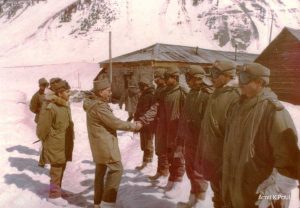
Maj. Gen. Kathpalia seeing of 19 KUMAON at Baltal before they crossed the Zojila. Lt. Col. D K Khanna can be seen behind Maj. Gen Kathpalia
19KUMAON:
Around 18th March 1984, 19 KUMAON started its 630 kms. journey from Khrew to the Nubra Valley via the Srinagar-Sonamarg-Zojila-Kargil-Leh-Khardungla route. This movement was done in complete secrecy. It was not officially reported to any other Department, no situation reports were filed through the Corps of Signals and no radio communication was done. All communication was only through the physical line laid on the ground as no indication was to be given about the induction of additional troops in that area.
After crossing the Zojila and KhardungLa on foot with full battle loads, the last column of the Battalion under Major Julka reached Sasoma around 18th April 1984.On 22nd April1984, the Army Commander directed patrolling of all Southern Glaciers which included Gyong La, Lagongma, Layogma,Urdolep and Korisa to counter infiltration attempts by Pakistan.
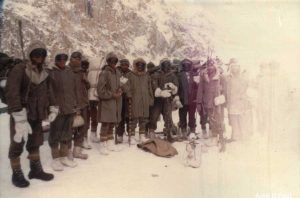
Lt. Col. D K Khanna (with the stick) seeing off 2/Lt. Anant Bhuyan (standing to his left as we see with the white of the flag visible under his arms) and others as they head to point 5705.
Accordingly as per directions of Lt. Col. D K Khanna, CO 19 KUMAON, its D Company under Maj. Julka started patrolling Lagongma and Layogma, B Company under Maj. Negi took charge of Gyongla and Zingrulma while the C Company under Maj. R S Hooda occupied the Urdolep Glacier in the South. On 25th April Captain Roshan Yadav and his team of ski troops opened the path to Indira Col and planted the National Flag on it.
Around 10th May the Army Commander directed that all possible approaches between NJ 9842 along the Saltoro Range up to Indira Col be dominated by patrolling. Since the Sector Commander had observed enemy movement near Gyong La during an aerial recce 19 KUMAON was directed to proceed to the ridge line and occupy it. On 23rd May 2/Lt. Anant Bhuyan braving enemy fire occupied Point 5705 near Gyong La.
In their attempt to occupy Point 5965 a team of 18 soldiers led by 2/Lt. Poondir met with an avalanche and were martyred on 29th May 1984. To dominate Gyong La it was felt that the OP Hill post just ahead of Point 5705 should also be occupied. With highly accurate and effective Mortar and MMG fire Captain Sanjay Agarwal occupied this post on 2nd June after inflicting casualties on the other side. OP Hill is the closest post to any Pakistani position on the Siachen Glacier and after its occupation and the surrounding areas domination over Gyong La was complete.
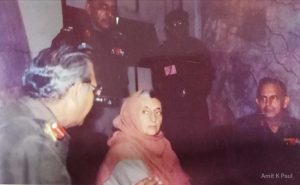
Mrs Gandhi being briefed on the Operation. We can see from left to right Lt. Gen Hoon, Maj. Gen Shiv Sharma (standing) and on the extreme right Lt Gen Chibber (sitting).
The Final Positions:
By the end of this induction and occupation phase of the Operation, 4 KUMAON was in occupation of Bilafond La, Ladakh Scouts was controlling Sia La/Indira Col and 19 KUMAON was dominating Gyong La and the glaciers south of it. With the Indian occupation of the Saltoro Heights complete as per plan, the then Prime Minister Mrs. Indira Gandhi specially flew in to boost the morale of the troops and take stock of the situation.
With all the three main passes effectively controlled by India all infiltration routes to the glacier were blocked and the Pakistani positions were relegated to the lower westward slopes of the Saltoro Ridge and locations from where the Siachen Glacier is not even visible. And that is where they are even till this day.
Author’s Note:
While several tasks were completed by various formations during this initial phase of Operation Meghdoot the objective herein is to give the reader a conspectus of the troops involved, their deployment and tasks.
Post your Comment
2 thoughts on “The Long March to Siachen”
 Loading Comments
Loading Comments



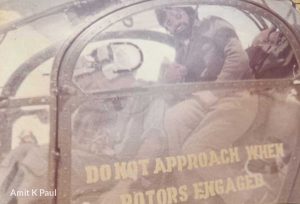
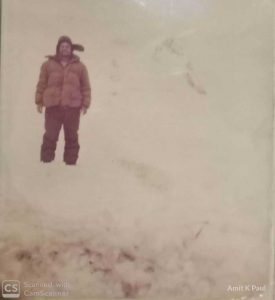
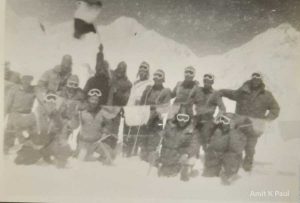
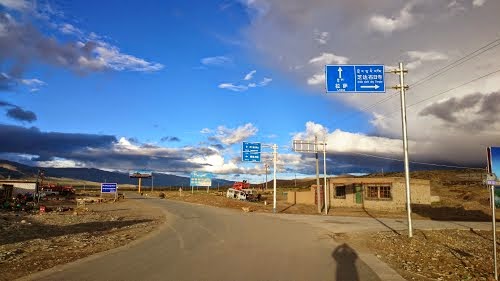
An unbiased and very candid article published in Indian Defence Review.
Describes in brief Operation Meghdoot, the Capture of Siachen Glacier by Indian Army. Siachen Glacier is the highest ongoing battlefield in the world.
The unsung hero General Amarjit Singh, the Sikh General standing in the pictures, who planned the entire operation in his role of MGGS NORTHERN COMMAND and attacked on April 13, 1984 Baisakhi Day.
April 13 was also the Raising Day of his Regiment 1st Jammu & Kashmir Rifles (1 JAK), 151 years ago on April 13, 1873 — also called Raghupratap Rifles.
A cracker of an article. Amit Paul has repeatedly turned out extremely informative articles on the Saichen issue. The earlier ones beautifully reconstructed the legal background to the dispute. And this one, the tactical aspects. Sweet!